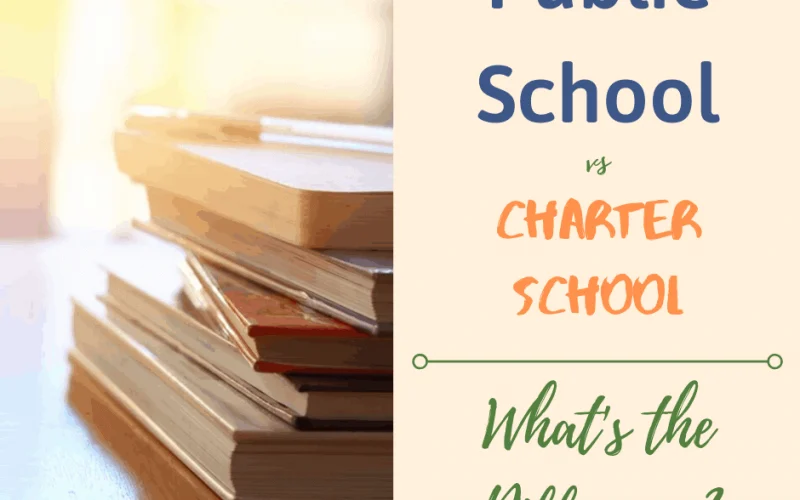Charter schools and public schools can seem similar on the surface, but they actually have some key differences. If you’re trying to decide which is the best fit for your child, you’ll want to understand how they differ and what they have in common. This is an article on charter school vs public school.
In the United States, public schools and charter schools are both free and open to all students, regardless of family income, thanks to taxpayer funding. Most traditional public schools offer the same classes in all locations and follow a predetermined district-designed curriculum.
Charter schools are publicly funded, just like traditional public schools, but they’re run by independent organizations. This means that they can be a bit more flexible in their curriculum and teaching methods.
We’ve explained some other differences and similarities between these two below.
Table of contents
- About Charter Schools
- What exactly are Charter Schools?
- About Public Schools
- Getting into a Charter School vs Public School
- What are the similarities between Charter School vs Public School?
- What are the Differences between Charter Schools and Public Schools?
- What advantages do Charter Schools have over public Schools? | Charter school vs Public school
- What advantages do Public schools have over Charter schools?
- Between Charter school and Public school, which is best for me?
- FAQs
- Conclusion
- References
- Recommendations
About Charter Schools
Since the early 1990s, charter schools have only existed for a relatively short period. The idea of contract schools was first presented by Beam Budde, a teacher at the College of Massachusetts, in a paper he wrote in 1974. However, charter schools did not begin to gain traction as an alternative to conventional public schools until the 1990s.
In 1991, Minnesota passed the first charter school law, allowing for the establishment of privately run, publicly funded schools. Soon after, additional states followed suit, and by 1995, charter school laws had been enacted in 19 states.
To increase innovation and enhance educational outcomes, charter schools were initially established as an alternative to traditional public schools.
Throughout the 1990s and 2000s, charter school enrollment increased rapidly, gaining popularity quickly. There are currently over 7,500 charter schools serving over 3 million students in the United States.
Read: Buffalo United Charter School: What to Know Before Applying in 2024
What exactly are Charter Schools?
Charter schools rarely have a selective admissions policy, as public schools do. Anyone in the school district can apply, and attendance is free for students. If applications surpass the school limit, students will be chosen by a lottery system.
Charter schools, in contrast to public schools, are run by educators, parents, universities, and other groups who want to provide children in their communities with alternative educational opportunities.
Sometimes, these groups want more than what their local public schools offer; for example, they need to use non-traditional teaching techniques or represent considerable authority in specific branches of knowledge (say science, craftsmanship, or literature) to encourage their students’ scholarly achievement.
A private board of education runs a charter school. It receives funding from public education budgets, but the private board manages the funds.
About Public Schools
The historical backdrop of public schools in the US traces back to the mid-nineteenth century. Education was mostly private before the 19th century, with families either paying for private tutors or homeschooling their children.
However, as the country began to industrialize and expand, it became increasingly clear that an educated populace was essential for social progress and economic expansion.
In 1635, Massachusetts established the first public school in the United States. However, public education did not become widespread until the middle of the 19th century. The first law requiring all children between the ages of 8 and 14 to attend school was enacted in Massachusetts in 1852.
Different states before long stuck to this same pattern, and by the mid-twentieth century, public education was compulsory in each state.
At first, school districts relied on property taxes to pay for education, which was how public schools were initially funded at the local level. However, with the passing of laws like the Elementary and Secondary Education Act (ESEA) and the No Child Left Behind Act (NCLB) in the 20th century, the federal government played a larger role in education.
Today, public schools in the US serve over 50 million students, educating students of all foundations and capacities.
Public education continues to be a cornerstone of American society, providing opportunities for social mobility and economic advancement, although there are still significant disparities in educational outcomes between communities.
What are Public Schools?
Public schools are the most well-known type of education and can be found in essentially every local area in each state. School districts and boards are in charge of local public education and receive funding from grants and other financial awards besides a mix of local and state tax revenues.
Most public schools provide students with a variety of athletic and other extracurricular opportunities besides a standardized, well-rounded education.
It is essential that interested parents and guardians investigate which type of charter school is best for their children because of the many differences between them.
Getting into a Charter School vs Public School
Because many charter schools have a limited enrollment capacity and receive more applications than they can accept, gaining admission can be a competitive process. Here are some suggestions that might help you get into a charter school:
Getting into a Charter School
Conduct research on local charter schools
Look for charter schools that share your family’s values and objectives and your child’s academic and extracurricular interests.
Attend sessions to learn more
For prospective families, many charter schools hold open houses or information sessions. You can learn more about the school’s mission, curriculum, and admission requirements by attending these events.
Follow the application cycle cautiously
Application requirements for charter schools may include essays, interviews, or tests. Make certain to adhere to all guidelines and fulfill all time constraints cautiously.
Prepare to show your potential in the classroom
Students at many charter schools are expected to perform well academically and have rigorous academic programs. Make sure you are ready to show that you can do well in school by getting good grades, doing well on tests, and taking part in extracurricular activities.
Remain drawn in and speak with the school
Keep in touch with the school after you’ve submitted your application and let them know if you have questions. This can show your obligation to the school and assist with building a positive relationship with the confirmation group.
Consider applying early
Since many charter schools have rolling admissions, they accept applications all year long until they run out of space. Applying early can help you get a spot before the school fills up.
Getting into a Public School
Because public schools are required to educate all children in their designated attendance area, admission to a public school is typically straightforward. However, there are still a few things you can do to make sure the enrollment process goes smoothly:
Choose your preferred school
Your home address is typically used to assign public schools. Usually, you can contact your local school district or look online to find your designated school.
Collect the documents
To confirm your age, residence, and immunization records, public schools typically require specific documents. Before enrolling, make sure you have all the paperwork.
Go to enlistment occasions
Numerous public schools hold enlistment occasions, like open houses or direction meetings, to invite new families and acquaint them with the school’s staff and projects.
Register as early as possible
Because there may be limited space at some public schools, it is essential to register as soon as possible to guarantee a spot.
Get in touch with the school
Get in touch with the school’s administration or enrollment office if you have questions during the enrollment process.
Also, see: Brooklyn Prospect Charter School: What To Know Before Applying In 2024
What are the similarities between Charter School vs Public School?
Charter schools and public schools have some similitudes, including:
1. Funding
Citizens subsidize both charter schools and public schools. While public schools are run by the government, charter schools receive funding from the public but operate independently of the local school district.
2. Academic requirements
The state or federal government mandates that both types of schools meet certain academic requirements. They likewise depend on ordinary assessments to guarantee they are fulfilling these guidelines.
3. Teacher accreditation
Both public and charter schools require teachers to have licenses and certifications. Additionally, they must satisfy certain professional and educational requirements.
4. Student testing
Standardized tests must be given to students in both types of schools to assess their academic progress and determine whether they meet state or federal academic standards.
5. Policies against discrimination
Students can’t be treated differently in charter schools or public schools because of their race, ethnicity, religion, gender, or any other protected characteristic.
6. Accountability
Both kinds of schools are held accountable for meeting specific financial and academic requirements. They may likewise be liable to reviews and assessments to guarantee they are using their financing properly and giving quality training to their students.
What are the Differences between Charter Schools and Public Schools?
Charter schools and public schools differ in several ways, including:
1. Governance
Public schools are run by local or state governments, whereas charter schools are typically run by independent boards of directors.
2. Flexibility
The curriculum, teaching methods, and school policies of charter schools are more adaptable than those of public schools. They are not restricted in the same way that public schools are.
3. Admission
Charter schools are available to all students, yet they might have restricted limits and use a lottery framework to decide enlistment. Public schools, on the other hand, are expected to give training to all students inside their assigned participation region.
4. Funding
Taxpayers pay for charter schools, but they may also receive grants and private donations. While citizens exclusively support public schools.
5. Accountability
However, charter schools are not subject to the same level of oversight and regulation as public schools, although they are held accountable for adhering to several academic and financial standards.
6. Teacher certification
It’s possible that hiring procedures at charter schools will be more adaptable and that not all teachers will need to be licensed or certified by the state. On the other hand, most public schools expect all teachers to have the appropriate licenses and certifications.
7. Disability services for students
Students with disabilities must receive special education services from public schools, whereas charter schools may not provide the same level of services or have fewer resources.
Also, see: Woodmont Charter School: What To Know Before Applying
What advantages do Charter Schools have over public Schools? | Charter school vs Public school
The advantages charter schools have over public schools include:
- Preferring Inclusions and Involvement of that community: A significant benefit of a contract school is the weight on considerations and contribution of the local area for improving instructive and social development. The way of education and process allows the kid to flourish in certainty which is difficult to be accomplished in a customary school setting.
- Viable Learning: Conventional public schools don’t permit a chance to stray from their decent educational plan. The regular curriculum at charter schools is flexible enough to match real-world scenarios to the child’s needs.
- Restricted strength: The fact that charter schools have a learning environment that only allows for limited classroom strength is a unique advantage. It enables us to provide each student with greater flexibility and individual attention while simultaneously enhancing their particular interests and addressing their weaknesses.
- Autonomy: Charter schools have greater autonomy than traditional public schools, despite receiving some state funding. If a charter sees something not proper to the genuine situation, then they can change the cycle right away.
What advantages do Public schools have over Charter schools?
Here, are the advantages public schools wield over charter schools
- Accessibility: Charter schools may have a limited enrollment capacity and use a lottery system to determine enrollment, whereas public schools are required to accept all students who live in their designated attendance area.
- Accountability: While charter schools are held to the same academic and financial standards, public schools are subject to greater regulation and oversight.
- Resources: most times, charter schools have fewer resources than public schools, particularly in terms of facilities and funding. While charter schools may rely on private donations and grants besides public funding, property taxes, and state funding typically fund public schools.
- Special education services: Students with disabilities must receive special education services from public schools, which are required by law. Charter schools may not have the same resources or expertise to provide these services.
Between Charter school and Public school, which is best for me?
Determining whether a charter school or public school is best for you depends on several factors, including your individual needs, preferences, and goals.
When making this decision, you should think about the following:
- What do I require academically? Do I require specific services or accommodations because of special requirements or learning differences?
- What are my emotional and social requirements? Do I prefer a smaller school or a larger community with more people of different backgrounds?
- What hobbies do I have outside of school? Am I looking for a school that offers sports, music, or language classes?
- How good are the schools in your neighborhood? Do public schools in your area have a reputation for providing high-quality instruction? Are there any sanction schools in your space that have a decent standing?
- What is what is happening? Are you able to pay for the costs of attending a charter school, such as tuition and fees, or would a public school be more cost-effective?
- What is my own way of thinking about instruction? Do I esteem development and trial and error, or do I incline toward a more conventional instructive method?
The best school for you will ultimately be determined by several factors, including your personal education philosophy, social and emotional needs, extracurricular interests, and academic requirements.
When making this decision, it is essential to investigate both charter schools and public schools in your area, speak with teachers and students, and consider your requirements and preferences.
FAQs
There’s no simple answer. Both charter and public schools in Texas have pros and cons. Researching individual schools is key!
Charter schools are a mix! They’re publicly funded but operate independently, so they’re kind of like public schools with more freedom.
Charter schools receive public funding, but often less than traditional schools. They may also get money from grants and fundraising.
Conclusion
Naturally, it is essential to keep in mind that not all public schools are created equal, and some public schools may struggle to provide their students with an education of high quality.
Additionally, some charter schools might give amazing instructive open doors to their students. In the end, each student’s needs and circumstances will determine which school is best for them.
References
- Diffen.com – charter school vs public school
- USnews.com – charter school vs public school
- Methodschools.org -charter school vs public school





